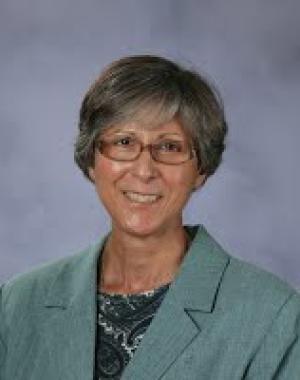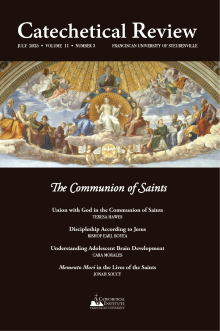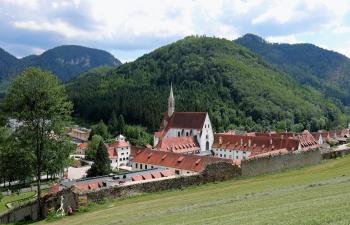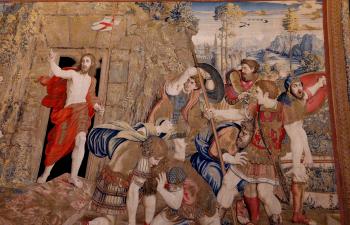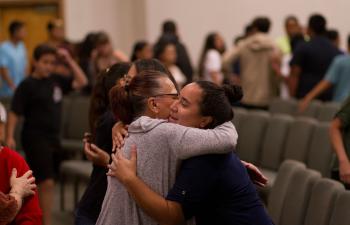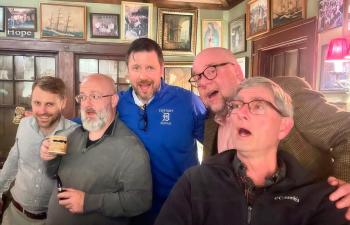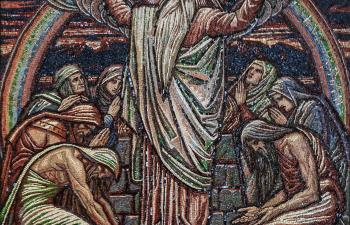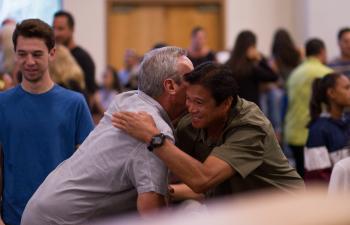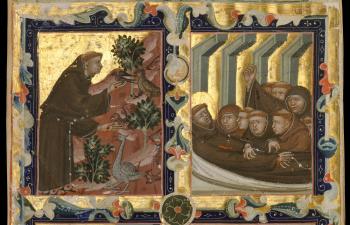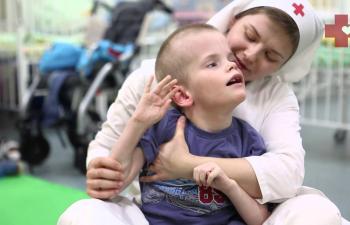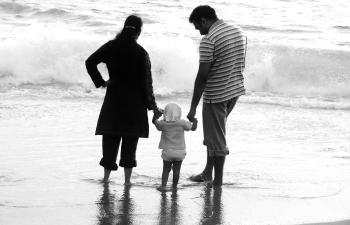 Recently in one of my religion classes, my ninth graders and I were thinking about how important the virtue of faith is in the Gospels. Faith usually seems to be a free-will assent that Jesus waits for in order to act in and through a person. But there is also the woman with the hemorrhage, whose faith draws healing power out of Jesus on its own (see Mk 5:30). Then there is the healing of the paralytic, which expanded our discussion to the Communion of Saints and the power of intercessory prayer: “when he saw their faith” (Lk 5:20), Jesus proceeded to heal the paralytic. One student pointed out that we don’t actually know whether the paralytic believed Jesus could do this. The man’s cure was provoked by the faith of his friends. What is this mystery? How are we united in Christ and with one another?
Recently in one of my religion classes, my ninth graders and I were thinking about how important the virtue of faith is in the Gospels. Faith usually seems to be a free-will assent that Jesus waits for in order to act in and through a person. But there is also the woman with the hemorrhage, whose faith draws healing power out of Jesus on its own (see Mk 5:30). Then there is the healing of the paralytic, which expanded our discussion to the Communion of Saints and the power of intercessory prayer: “when he saw their faith” (Lk 5:20), Jesus proceeded to heal the paralytic. One student pointed out that we don’t actually know whether the paralytic believed Jesus could do this. The man’s cure was provoked by the faith of his friends. What is this mystery? How are we united in Christ and with one another?
The ordinary means of this identification with Jesus is the Sacrament of Baptism. The sanctifying grace we receive is the very life of God in us; through baptism, we “come to share in the divine nature” (2 Pt 1:4). United to Christ, we are by that very fact united to God and so to one another. Jesus said, “I pray not only for them, but also for those who will believe in me through their word, so that they may all be one, as you, Father, are in me and I in you, that they also may be in us, that the world may believe that you sent me” (Jn 17:20–21). This is the reality of the Communion of Saints. Our personal sanctity is not the exclusive goal of our union with Christ; its ultimate purpose is the building up of the Body of Christ, the Church, the whole Christ. As CCC 1267 states: “Baptism makes us members of the Body of Christ: ‘Therefore . . . we are members one of another’ [Eph 4:25]. Baptism incorporates us into the Church. From the baptismal fonts is born the one People of God of the New Covenant, which transcends all the natural or human limits of nations, cultures, races, and sexes: ‘For by one Spirit we were all baptized into one body’ [1 Cor 12:13].”
Bl. Fr. Marie-Eugene of the Child Jesus, OCD, emphasizes that this union is the work of the Holy Spirit in and through each one of us: “We know that it is the Spirit of Love who carries out the eternal design of God. He placed the foundations for it by bringing to pass the mystery of the Incarnation in the womb of Mary. Since then, He continues His work by pouring into our souls a filial charity that identifies us with the Incarnate Word, Christ Jesus. This grace makes us one with Christ, that we may form with Him the whole Christ.”[1] In The Reed Of God, Caryll Houselander points out that this identification takes place slowly and, as its fruit, gives us God’s power to live his life here and now: “What we are asked to do is to be made one with Christ, to allow Him to abide in us, to make His home in us, and gradually, through the oneness that results from living one life, and through the miracles of His love, consummated again and again in Communion with Him, to become Christs, to live in Him as Our Lady did. When we are changed into Him as the bread into the Host, then with His power we can follow His example.”[2]
Houselander had stated earlier in her book that it is God’s will “that Christ shall be born in every human being’s life and not, as a rule, through extraordinary things, but through the ordinary daily life and the human love that people give to one another.”[3] Jesus explicitly articulates this identification with “ordinary daily life” in Matthew 25:40, when he says, “Amen, I say to you, whatever you did for one of these least brothers of mine, you did for me.” The sculpture Homeless Jesus by Timothy P. Schmalz movingly illustrates Jesus’ teaching.[4]
Union with God in the Life of the Martin Family
The wonderfully beautiful reality of this communion in love is that it is lived and shared in a multiplicity of forms. Let’s consider a few examples, illustrated here by the life of the human family of St. Thérèse of the Child Jesus (Thérèse of Lisieux).
In April 1896, Thérèse wrote to her blood sister, Léonie, who after many struggles had finally found her vocation as a Visitation sister: “I can love you with the Heart of our celestial Spouse. In Him we are living the same life.”[5] Thérèse knew she loved her sister with the love of Jesus. More than a bloodline, they shared his very life. Thérèse died on September 30, 1897. On June 28, 1899, the eldest of the Martin children, Marie, herself a Carmelite nun, wrote to Léonie before her reception of the habit, which only a cousin by marriage would be attending: “Your family, both those on earth and those in Heaven, are with you on this day—even your little Carmelites, for love has wings, and the heart and soul know no distances.”[6]
The Martin family had a strong sense of communion lived in God with both those on earth and in heaven. As Thérèse was dying, she wrote to Léonie on July 17, 1897: “You want me to pray in heaven to the Sacred Heart for you. Be sure that I shall not forget to give Him your messages and to ask all that will be necessary for you to become a great saint.”[7] In one of her last conversations, Thérèse had affirmed: “After all, it’s the same to me whether I live or die. I really don’t see what I’ll have after death that I don’t already possess in this life. I shall see God, true; but as far as being in His presence, I am totally there here on earth.”[8] Bl. Fr. Marie-Eugene comments: “So there is identification, and it is realized uniquely in the order of grace, through its development, and, we might say, without extraordinary graces. This identification with Christ which produces the fruitfulness of the apostles’ actions, attunes all the movements of their souls perfectly to the soul of Christ. They pray with Christ, in the light which is given. . . . This light reveals both the eternal Church and the Church in time.”[9]
Before she died, Thérèse expressed more than once her conviction that heaven and earth are inextricably united. “I want to spend my heaven doing good on earth. This isn’t impossible, since from the bosom of the beatific vision, the angels watch over us.”[10] During her last eighteen months of spiritual darkness, which was so terrible she feared she would blaspheme if she described it, Thérèse sensed that the life of the living God was mysteriously uniting her to all the people who claimed they didn’t believe in God. She knew she was suffering with and for them:
Your child . . . O Lord, has understood Your divine light, and she begs pardon for her brothers. She is resigned to eat the bread of sorrow for as long as You desire it; she does not wish to rise up from this table filled with bitterness at which poor sinners are eating until the day set by You. Can she not say in her name and in the name of her brothers, “Have pity on us, O Lord, for we are poor sinners!” Oh! Lord, send us away justified. May all those who were not enlightened by the bright flame of faith one day see it shine.[11]
Thérèse died at 24, having never left her carmel after entering. And yet, in the Communion of Saints, she reached the ends of the earth—and continues to do so. She is, in fact, Patroness of the Missions, equal to St. Francis Xavier, who traveled to India and the Far East to spread the Good News. Near the end of her autobiographical manuscripts, meditating on Song of Songs 1:4, “Draw me, we shall run,” she prayed: “I ask Jesus to draw me into the flames of His love, to unite me so closely to Him that He live and act in me.”[12] She knew that the more she was one with Jesus, the more the people she brought to him would be united to him as well.
The friends of the paralytic did everything they could—even breaking through the roof of a stranger’s house—to get their friend to Jesus. In the silence of her cloister, Thérèse offered herself to Jesus in order to bring unbelieving souls to him. Whatever our circumstances and state in life may be, when we live out our baptismal grace in our ordinary lives, we are united to the Communion of Saints, sharing Christ’s love and building up the Body of Christ.
[1] Marie-Eugene of the Child Jesus, OCD, I Am a Daughter of the Church: A Practical Synthesis of Carmelite Spirituality, vol. 2, trans. Sr. M. Verda Clare, CSC (Fides Publishers Association, 1955), 612.
[2] Caryll Houselander, The Reed of God (Christian Classics, 2020), 79–80.
[3] Houselander, The Reed of God, 12.
[4] Timothy P. Schmalz, Homeless Jesus, 2013, sculpture cast in bronze.
[5] Thérèse of Lisieux, Letters, trans. John Clarke, OCD, vol. 2, 1890–1897 (ICS Publications, 1988), 951.
[6] Marie Baudouin-Croix, Léonie Martin: A Difficult Life, trans. Mary Frances Mooney (Veritas, 1993), 78.
[7] Thérèse of Lisieux, Letters, 2:1149.
[8] Thérèse of Lisieux, Her Last Conversations, rev. ed., trans. John Clarke, OCD (ICS Publications, 1977), 45 (May 15, no. 7).
[9] Marie-Eugene of the Child Jesus, OCD, Where the Spirit Breathes, trans. Sr. Mary Thomas Nole, OP (Alba House, 1998), 283–84.
[10] Thérèse of Lisieux, Last Conversations, 102.
[11] Thérèse of Lisieux, Story of a Soul, 3rd ed., trans. John Clark, OCD (ICS Publications, 1996), chap. 10, 6r.
[12] Thérèse of Lisieux, Story of a Soul, chap. 11, 36r.
Art Credit: Homeless Jesus, Dennis Jarvis; flickr.com.
This article originally appeared on pages 9 - 14 of the print edition.
This article is from The Catechetical Review (Online Edition ISSN 2379-6324) and may be copied for catechetical purposes only. It may not be reprinted in another published work without the permission of The Catechetical Review by contacting [email protected]

